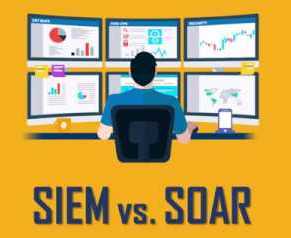The Battle Continues Between SIEM and SOAR, What are the Differences?
Security Information and Event Management (SIEM) and Security Orchestration, Automation, and Response (SOAR) are two important technologies that are used to improve an organization’s cybersecurity posture. While these technologies share some similarities, they are designed to perform different functions and have their own unique features.
SIEM is a security platform that aggregates, analyzes, and correlates data from various sources (such as logs, network traffic, and security alerts) to identify potential security threats and vulnerabilities. Some key features of SIEM include:
- Real-time monitoring and analysis: SIEM systems are designed to continuously monitor and analyze data from multiple sources in real-time, providing a comprehensive view of the organization’s security posture. This can include things like detecting unusual network traffic patterns, identifying malicious activity, and alerting the appropriate personnel.
- Threat intelligence: SIEM systems can incorporate threat intelligence from external sources (such as threat feeds and open-source intelligence) to improve their ability to detect and respond to threats. This can include information about new vulnerabilities, malware variants, and other types of threats that may not be detectable through traditional means.
- Compliance: SIEM systems can help organizations to meet various cybersecurity standards and regulations (such as PCI DSS and HIPAA) by providing the necessary controls and reporting capabilities. This can include things like generating compliance reports, monitoring for compliance violations, and alerting the appropriate personnel if a violation is detected.
- Correlation and analysis: One of the key capabilities of SIEM systems is the ability to correlate and analyze data from multiple sources to identify patterns and trends that may indicate a security threat. This can include things like identifying a series of failed login attempts from the same IP address, or detecting the use of a known malware strain on multiple systems.
SOAR, on the other hand, is a technology that automates and coordinates the response to security threats and incidents. Some key features of SOAR include:
- Automated response: SOAR systems use automated processes and rules to respond to security incidents, allowing organizations to take immediate action without the need for manual intervention. This can include things like blocking malicious traffic, quarantining infected systems, and alerting the appropriate personnel.
- Workflow management: SOAR systems can automate and coordinate the workflow of incident response activities, helping to ensure that the appropriate actions are taken in a timely manner. This can include things like assigning tasks to the appropriate personnel, tracking the progress of response activities, and escalating incidents if necessary.
- Integration: SOAR systems can integrate with a wide range of security tools and technologies (such as SIEM, threat intelligence feeds, and ticketing systems) to improve the efficiency and effectiveness of incident response. This can allow the SOAR system to automatically gather additional information about an incident, or to trigger the execution of a specific response action based on the severity of the incident.
- Playbooks: SOAR systems often include pre-defined playbooks that outline the steps to be taken in response to specific types of incidents, such as malware outbreaks or phishing attacks. These playbooks can help to ensure that the appropriate response actions are taken in a consistent and predictable manner.
In summary, SIEM and SOAR are two important technologies that can improve an organization’s cybersecurity posture. SIEM is a security platform that aggregates and analyzes data to identify potential threats, while SOAR is a technology that automates and coordinates the response to security incidents. While these technologies share some similarities, they have their own unique features and are designed to perform different functions. By implementing both SIEM and SOAR, organizations can improve their overall cybersecurity posture and better protect their assets, data, and reputation.
Walk me through the value of having a SIEM and a SOAR working together seamlessly…
Having a Security Information and Event Management (SIEM) system and a Security Orchestration, Automation, and Response (SOAR) system working together seamlessly can bring significant value to an organization.
First and foremost, combining SIEM and SOAR can significantly improve an organization’s incident response capabilities. With SIEM, organizations can quickly and accurately identify potential security threats and vulnerabilities by aggregating and analyzing data from various sources (such as logs, network traffic, and security alerts). SOAR, on the other hand, automates and coordinates the response to security threats and incidents, allowing organizations to take immediate action without the need for manual intervention. By integrating SIEM and SOAR, organizations can quickly and accurately identify and respond to security incidents, minimizing the impact of any attacks.
Another key benefit of combining SIEM and SOAR is the ability to improve efficiency and reduce the cost of security operations. Automating routine tasks and processes (such as scanning logs and analyzing network traffic) can free up time for security analysts to focus on more complex tasks and incident response. Additionally, automating incident response can reduce the need for additional staffing and training, resulting in cost savings.
But the value of combining SIEM and SOAR goes beyond just improving efficiency and reducing costs. By integrating these technologies, organizations can also improve their compliance posture and reduce the risk of regulatory fines and penalties. SIEM and SOAR can help organizations to meet various cybersecurity standards and regulations (such as PCI DSS and HIPAA) by providing the necessary controls and reporting capabilities. This can include generating compliance reports, monitoring for compliance violations, and alerting the appropriate personnel if a violation is detected.
In summary, combining SIEM and SOAR can significantly improve an organization’s cybersecurity posture, incident response capabilities, efficiency, cost effectiveness, and compliance posture. By working together seamlessly, these technologies provide a comprehensive and integrated approach to security management, helping organizations to better protect their assets, data, and reputation.
By: Chris Ichelson & Scott Myers, CISSP
Why 360 SOC?
At 360 SOC, we understand that no two organizations have the same security needs and requirements. That’s why we offer both Managed Detection and Response (MDR) and Security Operations Center as a Service (SOC as a Service), tailored to meet your unique security requirements. Our team of experts will work with you to understand your organization’s specific security needs and goals, and design a customized solution that delivers the protection and support you need to stay safe from cyber threats. With 360 SOC, you can feel confident that your organization’s networks and systems are in good hands, and that you have the tools and resources you need to effectively detect and respond to any security incidents.
Find out more about 360 SOC at www.360soc.com






